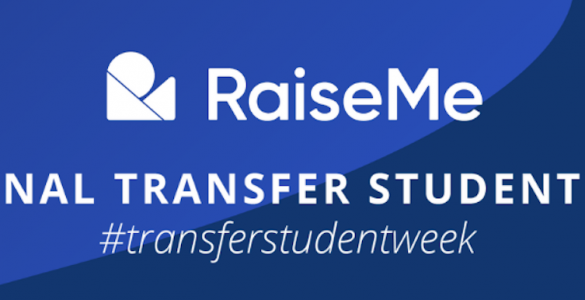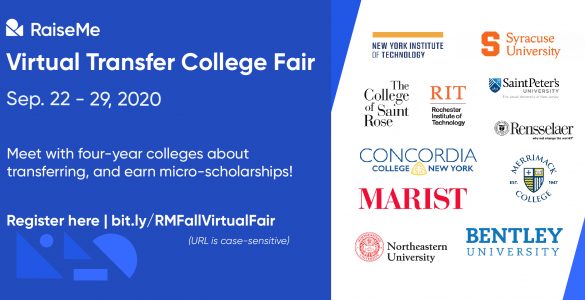RaiseMe & Guided Pathways: Creating a roadmap for transfer student success
If you are part of the community college world, it’s likely you are familiar with Guided Pathways, a set of best practices and expectations set forth by the American Association of Community Colleges (AACC) rooted in thought leadership from Bailey, Jaggars, and Jenkins. Essentially, they suggest that despite the best efforts of academic advisors students often select courses “cafeteria style”, creating a hodgepodge of credits that don’t necessarily stack up to a credential.
Guided Pathways makes a plea for purposeful, urgent advising, along with clear checkpoints for students. At its core, Guided Pathways initiatives seek to create transparency around how students can seamlessly take the courses they need to reach their goals, reduce credit loss, and strives to create renewed sense of interconnected purposefulness in academic advising and college success strategies.
Guided Pathways: disrupting the “cafeteria model” in community colleges
The analogy I like to make about what students experience is akin to giving someone a basket of baking ingredients, but no recipe. If no one tells you to preheat the oven, or how much yeast you need, you can still put the ingredients together, work hard, and end up with a dud loaf of bread. Guided Pathways is the recipe that orders the chaos of the educational “pantry”.
Advising loads are large, degree plans change (or, developmental education courses are not compatible with the plan), and students face enormous personal adversity. The question that looms for many institutions is how to satisfy the need for this intensive planning, but with limited resources?
Using RaiseMe micro-scholarships to support Guided Pathways directives
RaiseMe seeks to illustrate, as soon as students start their two year degree, what kinds of achievements and habits will keep them on track to graduate and transfer. For each achievement reached students can earn micro-scholarships that offset the cost of their four year degree, which provides a constant feedback loop of how their decisions today impact their future. The achievements that RaiseMe focuses on align with key performance indicators developed by AACC, reinforcing the message that early, frequent, and prompt feedback on a student’s progress is going to help keep them on track.
RaiseMe micro-scholarships include taking a full course load, earning good grades in college level courses, and participating in extracurricular activities. This chart illustrates how micro-scholarships awarded through RaiseMe align with KPIs found in the AACC Pathways Coaching Guide:
| RaiseMe Micro-scholarship | Guided pathways Key Performance Indicators (KPIs) [developed by the Community College Research Center (CCRC)]: |
| Getting an A or B in a 100 or 200 level course |
|
| Taking a full course load |
|
| Earning a high GPA |
|
| Associate’s degree completion milestone scholarships (15, 30, 45 credits) |
|
Additionally, the Pathways Coaching Guide makes the following recommendations regarding milestones and student engagement:
- Colleges should track each entering first-time-in-college student cohort through these early momentum points and then on to completion (or not) of certificates, degrees, and transfer
- Establish transfer pathways through alignment of pathway courses and expected learning outcomes with transfer institutions, to optimize applicability of community college credits to university majors.
- Aligning pathways with co-curricular experiences appropriate to the program
- Creating Inescapable student engagement
These touch points and out of classroom attributes are reinforced by RaiseMe via micro-scholarships for:
- Meeting with a transfer advisor at a four year institution
- Visiting with a four year college during an open house, or joining a co-enrollment program
- Community service & volunteerism
- Joining Phi Theta Kappa
- Joining Student Government
- Participating in athletics, clubs, and taking on leadership positions
Micro-scholarship theory rooted in behavioral research on student outcomes
Nudge theory, popularized by Thaler and Sunstein, asserts that patterns of behavior or decision making can be swayed by small adjustments to our “choice architecture”. Choice architecture represents the way choices are presented to students, and our capability to change student behavior by repackaging the options they have. As we change the menu of choices we present to students incremental nudges, or incentives, can motivate them to make positive choices based in the architecture (or, pathway) we develop for them.
For example, summer melt is a problematic phenomenon that is costly for colleges, and detrimental to students. Historically, calls to action around submitting transcripts or making deposits might arrive to students in a string of emails or letters, leaving them overwhelmed. In 2016 Georgia State implemented nudges during the enrollment process via Pounce, a virtual assistant that reminds students via text message to submit outstanding items. As a consequence, Georgia State saw a 21.4% reduction in summer melt.
The enrollment tasks reminded identical to what they have always been; submit your FAFSA, arrange your housing, send your transcript, and so forth. The presentation of the choice, and the frequency of touch points from the college changed, impacting student behavior. Bailey (2015) notes, in considering a pathways approach, “Reminders, assistance, and feedback can increase desired behaviors” making the relationship between a Nudge Theory and Guided Pathways clear.
Incorporating RaiseMe into your campus’ transfer advisory program
Other ways, aside from micro-scholarship offerings, that RaiseMe may align with your institution’s work around Guided Pathways includes:
- Intrusive Advising: RaiseMe’s free educator portal allows advisors to see the schools your students are interested in transferring to, their portfolio of activities, and how much they are earning.
- First Year Experience: RaiseMe has transfer focused classroom materials that discuss early planning, financial literacy, and more!
- Early Intervention: RaiseMe allows students to forecast how much they can earn with different combinations of final grades. Showing students how much they can earn by improving their grades can keep them on track.
Request an educator portal account at www.raise.me/educator, and select “community college”. Then, start accessing resources and data that can keep students on their roadmap to success!
Want to partner with RaiseMe to introduce micro-scholarships to your students? Contact Tara Zirkel, tara@raise.me.
You may also like

National Transfer Student Week 2020: Celebrate With RaiseMe!
Join RaiseMe in celebrating National Transfer Student Week October 19th-23rd. This is a week to celebrate our students, connect them with resources, and to...

Join RaiseMe’s Virtual Transfer Fairs: September 2020
During RaiseMe’s Virtual Transfer Fair, community college students can earn micro-scholarships for visiting with colleges, right from home. Students: we know it has...

RaiseMe: Everything Educators Need To Know for Back-to-School and More
A comprehensive overview for getting your high school students started with RaiseMe.

